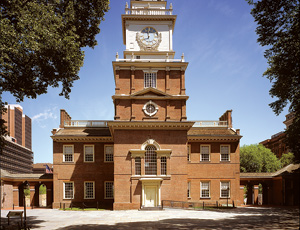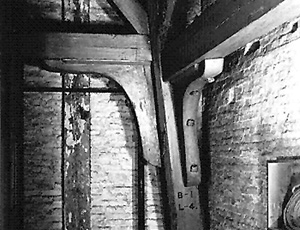Structural engineers from Keast & Hood are a bit baffled in the belfry of historic Independence Hall in Philadelphia. As part of a planned $4.3-million renovation, triggered by leaks in the landmark’s tower, the local firm discovered that several lines of iron rods, which run vertically down the center of the tower’s 2.75-in.-thick wooden siding, have significantly deteriorated. But the team doesn’t know why the rods are there in the first place, so they don’t know if they need to be repaired or replaced.


“They don’t seem to have a structural function from what we can tell,” says Suzanne Pentz, K&H project manager. “We haven’t found another building built in the same manner.”
The tower was designed by William Strickland in 1828 as a replacement for the original 1750 tower. The structure is a heavy timber frame with bolted connections, not mortise-and-tenon joints. The major connections use ship knees cut from an angled intersection of the trunk and branch of an oak tree. The frame includes four columns angled in a pyramid shape. Tower enclosures are wooden boxes. The siding does not directly connect to the main structure.
The hall “has great architectural significance,” says Charles Tonetti, chief historical architect at Independence National Historical Park of the National Park Service. The tower is one of America’s earliest examples of colonial revival architecture, he says.
Unlike clapboard siding, the boards do not overlap but rather have a flush connection with a shiplap joint. The 5/8-in.-thick rods run the length of the boards and are bolted at the ends. The rods may have been used to minimize shrinkage, says the engineer. There also may be a connection to canal boat construction. “We have some clues that 19th-century boats may have been built this way,” Pentz says, but no canal boats survive to study.
X-rays revealed several sections in which water had penetrated siding joints and seeped into rod holes, making some rods appear nearly three times their original thickness. However, Terry Amburgey, a plant pathologist at Mississippi State University, suspects a condition known as iron sickness, in which iron oxide in corroded areas may have actually seeped into the siding. If this is the case, the rods may actually have lost thickness, says Pentz.
Construction is set to start in 2011. The city and the NPS still must approve a restoration plan. Before that, they must decide whether to address only water infiltration, remove and replicate all the siding or replace some of the boards, reusing as many originals as possible.
“We need to determine the method that best fits current preservation philosophy—preserving appearance, maintaining the structure and preserving historic materials,” says Cynthia MacLeod, park superintendent.
Regardless of the plan, Pentz expects the unusual rod system to remain. Damaged rods may be replaced with stainless steel, she adds.


Post a comment to this article
Report Abusive Comment